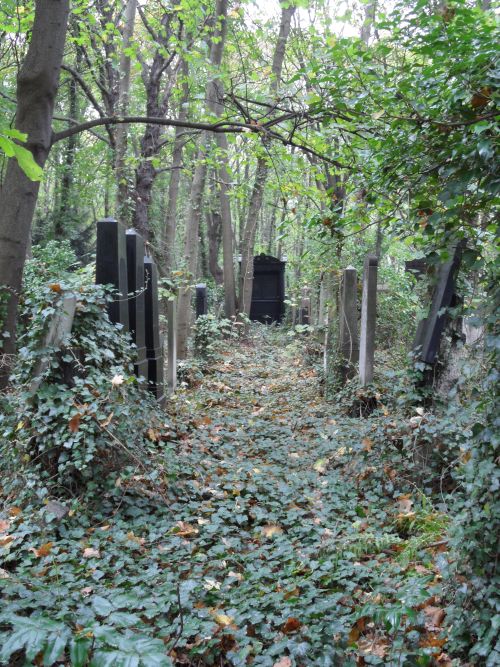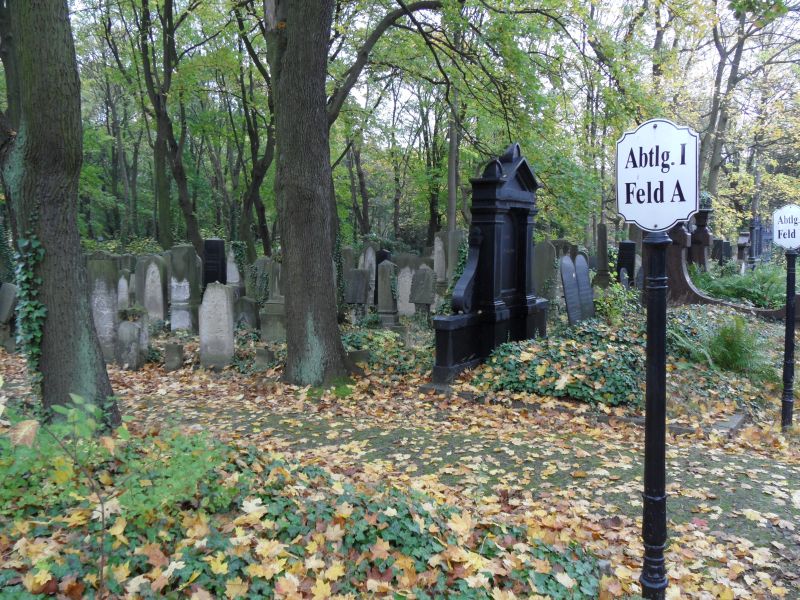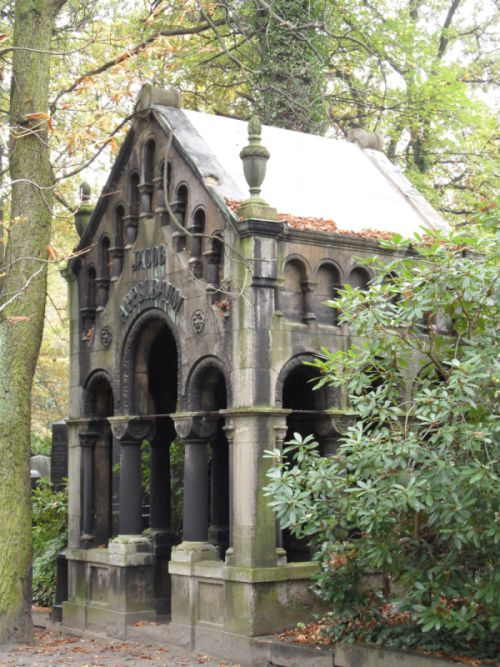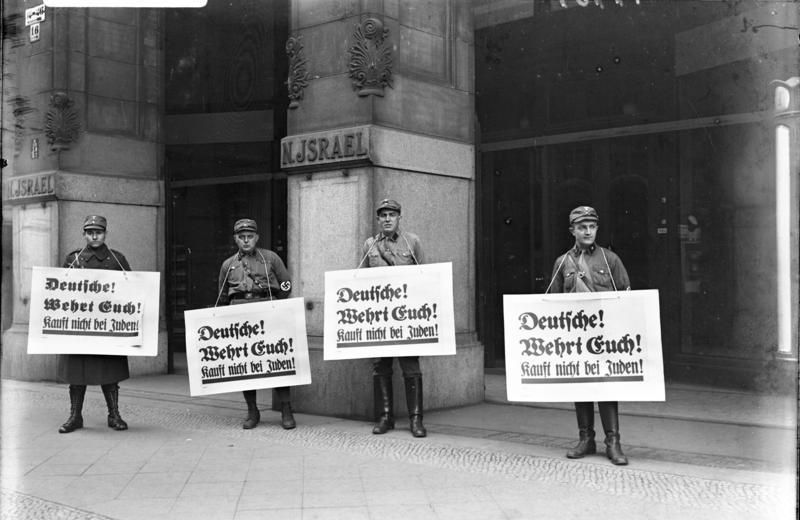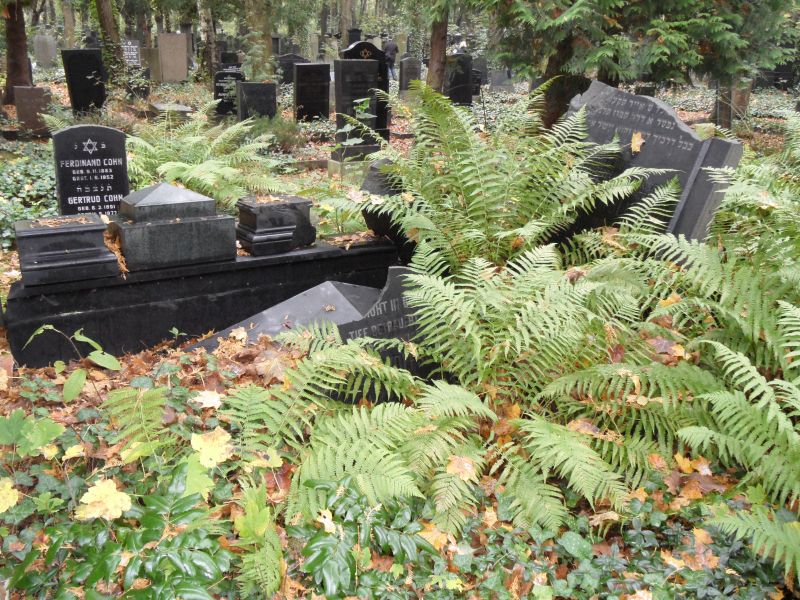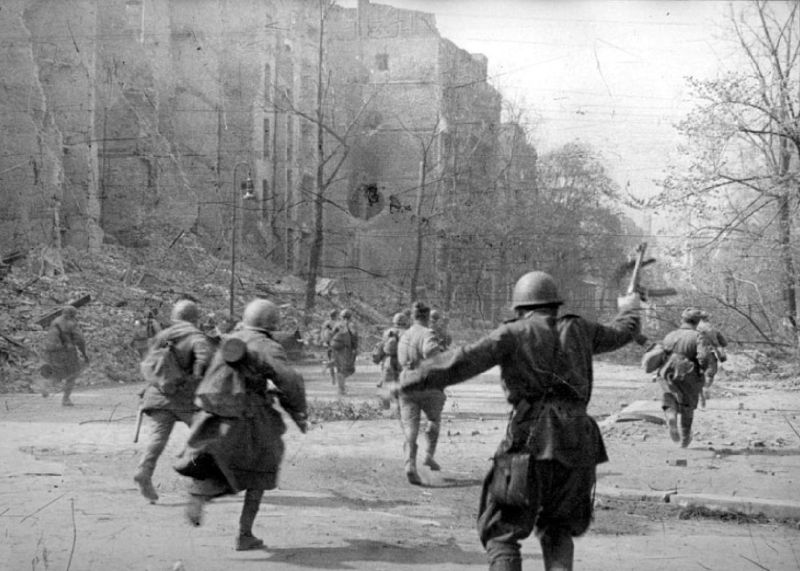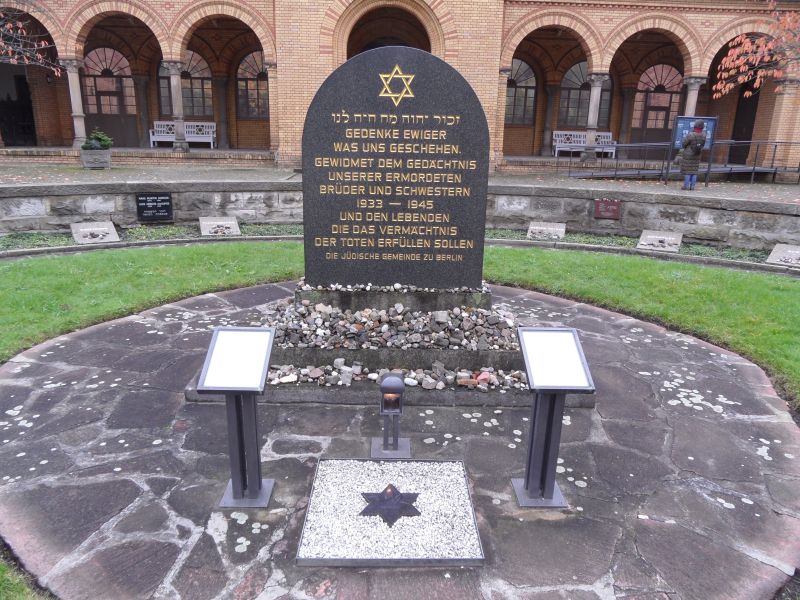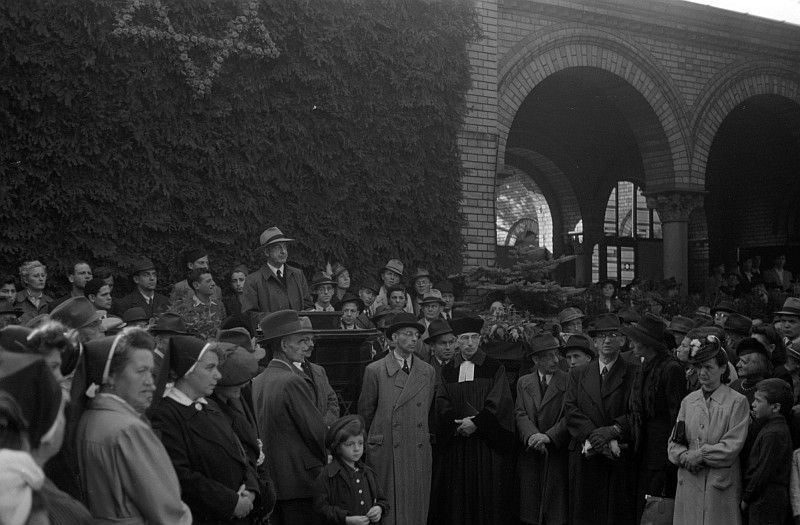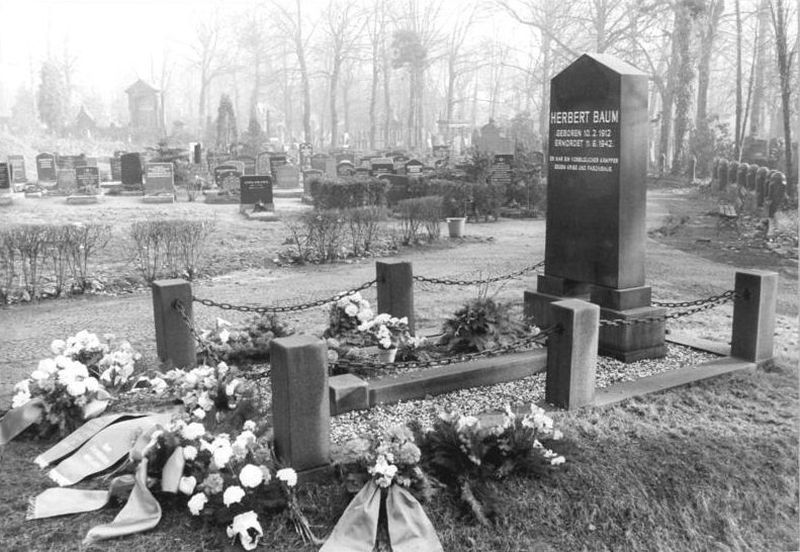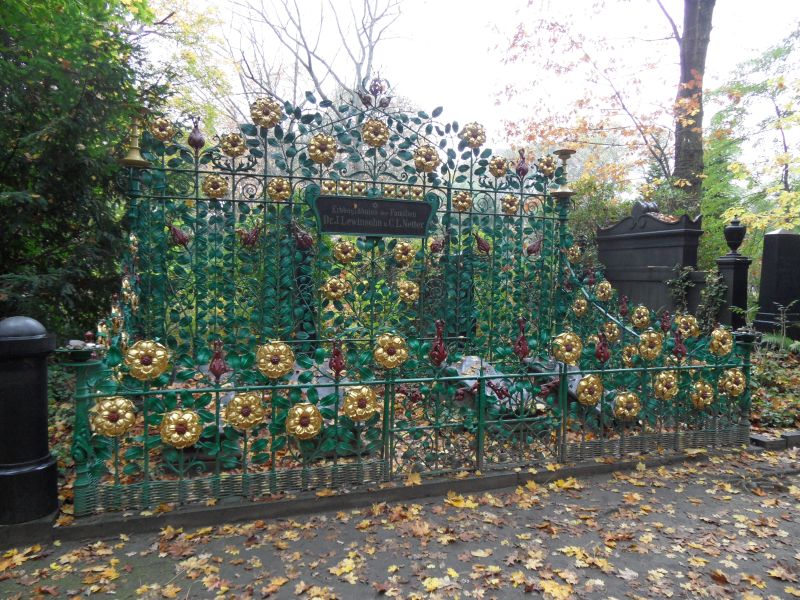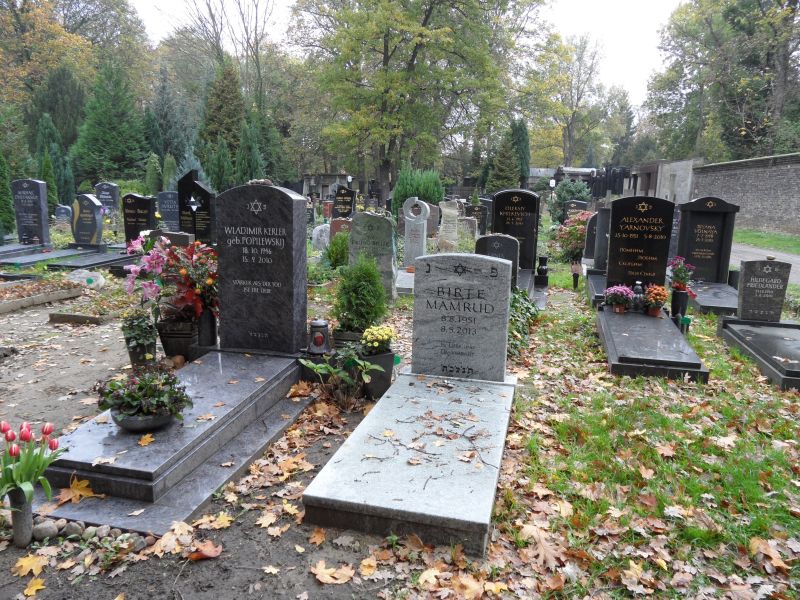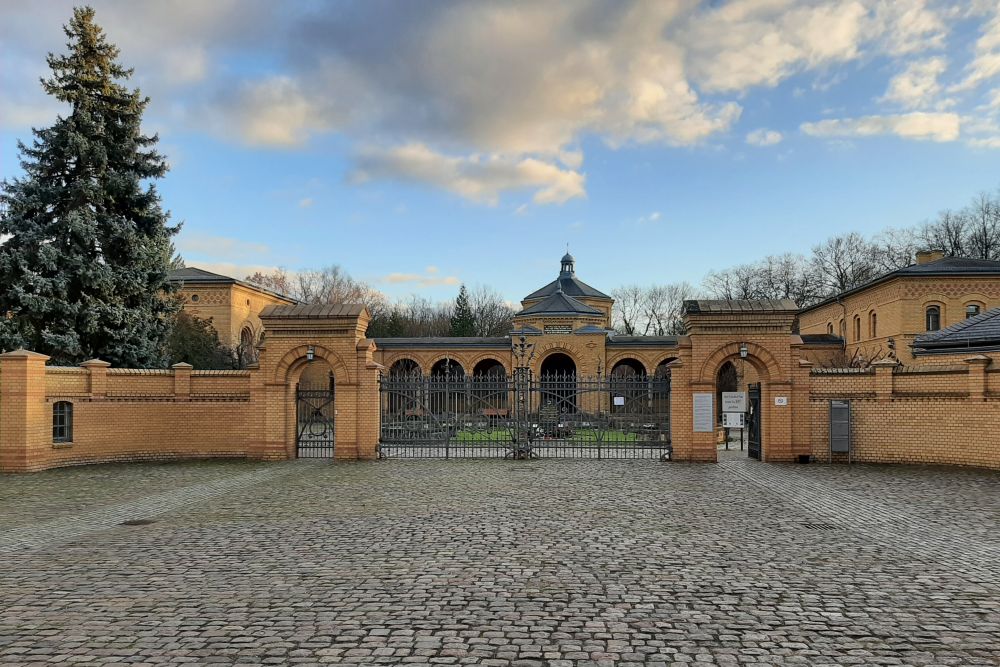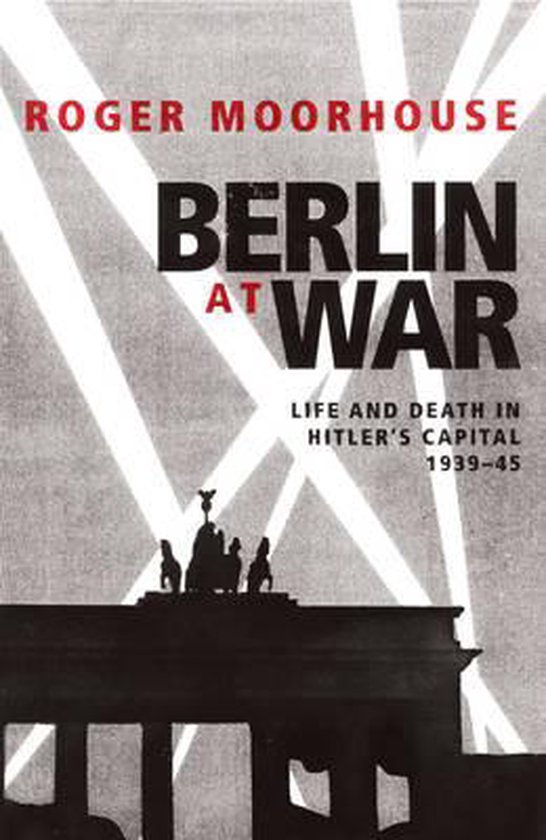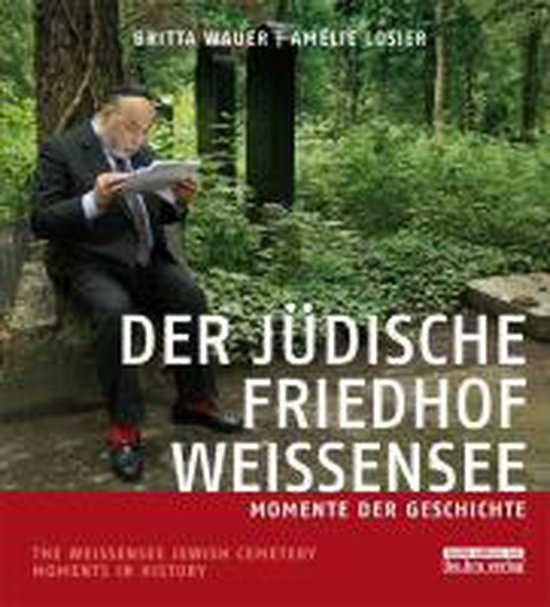Before the war
Decayed tombstones and impressive mausoleums stand in a green sea of ivy, fern and young trees. In summer the sunrays hardly penetrate the thick foliage of high trees, creating a mystic mood on the dusky cemetery. The sudden view on the Berlin TV tower, reaching into the sky a few miles away forms a sharp contrast with the faireytale like environment. In the middle of the agglomeration of the German capital, this vast Jewish cemetery Weissensee with its 115.600 grave sites is a world all its own which testifies to a rich Jewish history but also to the downfall of the Berlin Jews in the period of Nazi rule.
Prosperity1869 was a joyous year for the Jews in Prussia and other states of the North-German Federation (1866-1871). From that year onwards they were made equal to Christians by law. The period of the blossoming Jewish community in Berlin, with 170.000 individuals the largest Jewis community in Germany, had started. Helped by their new freedom, many Jews climbed the social ladder with great speed and made names for themselves in science, culture and the world of trade. It was for instance the Jewish trademan Adolf Jandorf who opened the KaDeWe in Berlin in 1907, still the best known department store in Germany today. No less prominent was the Jewish wine merchant and gastronomer Berthold Kempinski whose name lives on in the international chain of hotels he founded.
Prior to 1880, the Jewish community already had two cemeteries at its disposal but due to a shortage of space, a third one was opened in the village of Weissensee, just outside Berlin (today a suhurb in the Pankow district). The former village took its name from the lake at some 0.62 miles from the cemetery. Its designer was the renowned German architect Hugo Licht, himself not of Jewish descent. He divided the area, measuring some 103.78 acres (about 80 football pits) into dozens of triangular and square plots bordered by footpaths. Although all plots had their unique letter and number, making them easier to locate, the lay out strongly resembles a labyrinth, the impression made stronger by the dense undergrowth.
The Jews of Berlin were prosperous, as still can be seen at the cemetery. Thriving Jewish families seemed to compete for possession of the largest and most expensive grave. For instance, the mausoleum, built of polished granite of the banker and entrepeneur Sigmund Aschrott († 1915), had cost 500.000 Reichsmark. Even today, the bombastic mausoleum is still the largest in Berlin. Apart from the entrepeneurs mentioned earlier, Jandorff († 1932) and Kempinski († 1910), other prominent Jews also found their last resting place at Weissensee; among them for instance the philosopher Hermann Cohen († 1918), one of the most important Jewish thinkers of the 20th century. The cigarette manufacturer and sponsor of sports, Josef Garbáty, publisher Samuel Fisher and Albert Einstein’s aunt and uncle were buried here as well.
From integration to exclusionApart from the grandeur and beauty displayed by many graves, something else is conspicuous: the inscriptions on many tombstones are in German and not in Hebrew and sometimes praise the Germany nationality of the deceased. The inscription: "A genuine German Jew of most noble descent" can be read on one of the tombstones. Knowing the crimes that were committed against the Jewish population on behalf of the German nation, it is a bizarre text but under the rule of Kaiser Wilhelm (1888-1918) many Jews were so well integrated that they felt more German than Jewish. An example of this integration are some 120.000 Jewish soldiers who served in the Imperial army during the First World War. Of the approximately 12.000 Jews who died in German military service, 400 of them were buried in a field of honor at Weissensee. In 1927 a monument was erected near the military graves by the Reichsbund Deutscher Frontsoldaten (association of German front soldiers) which held a memorial service there every year up to 1936.
After the seizure of power by the Nazis in 1933, the position of the Jews in German society deteriorated dramatically. The equal treatment, granted to them in 1869 was no longer valid and exclusion became their fate. Just like the Jews, the Jewish cemetery Weissensee would slide down to a marginal existence. Some time earlier, the end had come for the era of expensive mausoleums, a result of the Great Depression that had also hit the Jews in Berlin. The outward appearance of many existing graves also changed as metal parts, especially fences were being removed in order to be melted down for use in the war industry. This was also done with the metal in Christian cemeteries. Metal or bronze characters on tombstones were exempted.
Although cremation is not permitted in Jewish religion, since 1926 urns were also admitted to the cemetery. Prior to the deportation of the Berlin Jews in 1941, approximately 300 urns containing the ashes of Jewish inmates arrived from various concentration camps. In order to save money and as a final humiliation of the deceased, these urns were made from paper maché. The urns were entombed at the cemetery where a number of them would be washed away as a result of flooding. Today, the names of the deceased Jewish inmates, who found their last resting place at Weissensee, are displayed on a commemoration wall in the cemetery.
Definitielijst
- Jews
- Middle Eastern people with own religion that lived in Palestine. They distinguished themselves by their strong monotheism and the strict observance of the Law and tradition. During World War 2 the Jewish people were ruthlessly persecuted and annihilated by the German Nazis. . An estimated 6,000,000 Jews were exterminated.
- Nazi
- Abbreviation of a national socialist.
Images
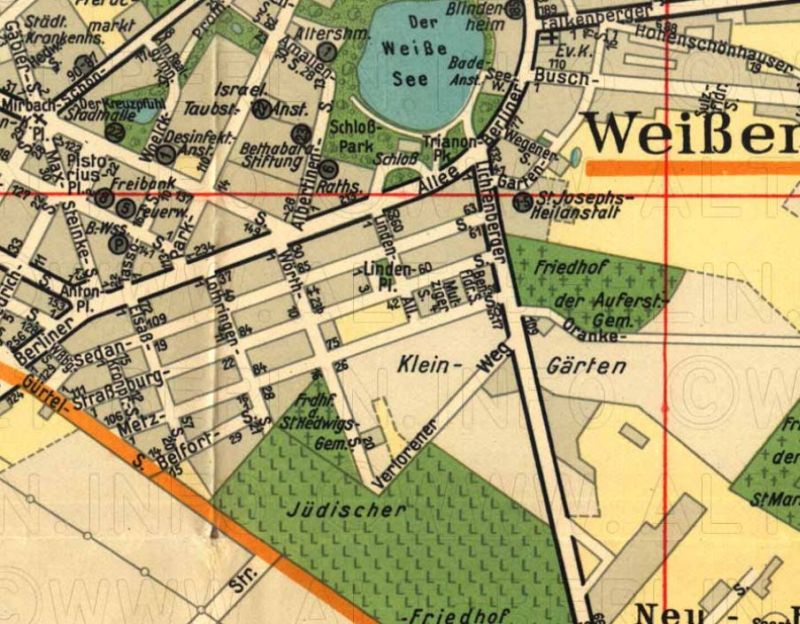 Detail of a map of Berlin in 1932, showing the location of "Der Weisse See" (White lake) and the cemetery. Source: www.alt-berlin.info.
Detail of a map of Berlin in 1932, showing the location of "Der Weisse See" (White lake) and the cemetery. Source: www.alt-berlin.info.During the war
In October 1941, the first trainload of Jews left Berlin for the East where the majority of all deportees wouild be murdered in camps and ghettos. At that time, some 70.000 Jews still lived in the German capital after tens of thousands had emigrated to escape discrimination and persecution. Many transports would follow until January 1945 but the Jewish cemetery in Weissensee remained operational all the time, albeit with increasingly less personnel. In the middle of the 20s the cemetery still had a staff of almost 70 funeral workers plus some 200 maintenance workers in the vegetable and flower gardens on the premises but in 1942, this had shrunk to a total of 100 personnel. At the end of the war, only 12 remained who were led by the rabbi Martin Riesenburger who was appointed in June 1943. All of them, including Riesenburger, were exempted from deportation thanks to their mixed marriage to an Arian partner.
Why did the cemetery remain open after the deportations and during the rest of the war? Probably for the same reason why the Jewish hospital remained open during the war years, although under German supervision. Jews who were exempted from deportation because of their protected marriage not only neeeded a hospital to be taken care of but also a cemetery to bury their dead. In this way, it was prevented that Jews would be buried in the same earth as an Arian which was, in Nazi ideology, unheard of. Moreover, by keeping the hospital and the cemetery in operation a semblance of normality was kept up in order to put the Jews themselves as well as the non-Jewish Berliners at ease. If the Nazi government allowed Jews to have their own hospital and cemetery in the capital of the Third Reich, their fate in the East could not be that bad.
SuicidesDespite the fact that the number of Jews in Berlin gradually decreased as a result of the deportations, funerals continued to be held at Weissensee. Mainly Jews from mixed marriages and the elderly who had not yet been deported were buried here after 1941. Another group that found its last resting place here were Jews who had committed suicide. Despondent by ominous rumors about the fate that awaited them, they chose suicide as a way out. Out of 2.556 funerals in 1941, 254 were because of suicide; in 1942 this had increased to 811 out of 3.230.
A tragic case of suicide is that of the couple Charlotte and Leopold Jacob who both committed suicide as early as 21 May 1940. Charlotte did this when her husband did not return before the curfew for Jews from a visit to family. She was out of her wits and, assuming her husband had been picked by the Gestapo, she took her life. When her husband did arrive later and discovered what his wife had done, the severely stricken Leopold also took his life. Charlotte would have turned 49 two days later and Leopold had turned 67 the day before, which was the reason for his visit to family. The couple was buried at Weissensee where 50 years on, a tombstone was erected by their three children who had survived the war.
OasisDuring the war, the cemetery was not only a place of misery. From 1942 onwards, the joyful sounds of children could be heard on the premises. A group of pupils between 13 and 15 years of age was put to work there after all Jewish educational institutions had been closed down. In summer they were to help taking care of the plants and in winter helped with shoveling snow. The stronger boys were employed for gravedigging. For recreation, they enjoyed themselves with athletics and football, something they could do on the premises without being bothered by Nazi hoodlums. Although a cemetery is not a ususal place for young adolescents, many of the Holocaust survivors who had been put to work there, stated they have fond memories of their time there. To them, the cemetery was an oasis of peace and quiet in the hostile world outside.
Safety was also the reason why Jews in hiding sought refuge in the cemetery. A remarkable hiding place was the mausoleum of opera singer Joseph Schwarz who died in 1926 and which was accessible through the roof. Hans Radziewski was one of many who found a safe haven for many nights on the cemetery. He knew the place like the back of his hand as he had worked in the gardens on the premises between 1939 and 1940 when Jews took an agricultural training prior to their emigration to Palestine. According to his own words, he hid himself after the Fabriksaktion, the massive razzia of February 1943, a dozen times in hollow spaces beneath tombstones where nobody had yet beeen buried. "I had two blankets there and something to eat. I had a place there where I could sleep a little." Hiding there was not without risk though as there was an SS bulding adjacent to the cemetery and during air raid alerts the SS men took the shortest route to the shelter.
Except for people, the cemetery was also being used to hide something else. In the spring of 1943, 538 thora rolls, in fact marked for a Nazi exposition on Jewry were hidden here by the manager of the cemetery, Arthur Brass and his staff. A non-Jewish mover had assisted transporting these parchment rolls that had been saved from the Nazis. A number of them were damaged during an Allied bombarment and subsequently buried pursuant to Jewish religious laws. The undamaged rolls would be presented to newly established Jewish communities after the war.
Bones in the mudIn 1943 and 1944 respectively, 931 and 244 burials took place, led by rabbi Riesenburger, even though Propagandaminister Joseph Goebbels had declared in 1943 that there were no more Jews left in Berlin. Riesenburger saw to it that Jewish laws were adhered to as much as possible and he performed, as the last remaining Jewish clergyman, religious ceremonies in the cemetery. Funerals were hardly ever attended to because in so doing, Jewish mourners then risked being picked up. With the small staff at his disposal, the rabbi no longer managed to care for the vast area properly, causing neglect to set in which would continue throughout the DDR era.
Just like the Jewish hospital, the cemetery at Weissensee survived the war rather undamaged. This in contrast to the other Jewish cemeteries in Berlin. The one on the Schönauer Allee, which was opened in the first half of the 19th century, was almost completely obliterated by Allied bombardments. During the battle for Berlin, tombstones were being used to put up barricades. The oldest Jewish cemetery, situated on the Grosse Hamburgerstrasse and which had been in use between 1672 and 1827, was razed to the ground in 1943 by order of the Gestapo. Shelters were dug beneath the terrain with tombstones being used to re-inforce the walls. In April 1945, mass graves for soldiers and civilians who had died in the fighting for Berlin, were dug on the former cemetery.
In comparison, some 4.000 damaged graves, the destruction of the mourning hall and the greenhouses on the cemetery at Weissensee were not so bad after all. Despite the fact that the damage was relatively limited, the sight of the cemetery after bombardments must have been horrible. "Bombs had landed in some fields, causing large craters and laying bare graves," a witness tesified. "It was shocking to see bones lying in the mud.". Numerous graves would be repaired after the war although in some places of the cemetery. bomb damage is still visible.
Definitielijst
- Holocaust
- Term for the destruction of European Jewry by the Nazis. Holokauston is the Greek term for a completely burnt sacrifice.
- ideology
- A collection of principles and ideas of a certain system.
- Jews
- Middle Eastern people with own religion that lived in Palestine. They distinguished themselves by their strong monotheism and the strict observance of the Law and tradition. During World War 2 the Jewish people were ruthlessly persecuted and annihilated by the German Nazis. . An estimated 6,000,000 Jews were exterminated.
- Nazi
- Abbreviation of a national socialist.
- raid
- Fast military raid in enemy territory
- razzia
- Organised round-up of a group of people. This could be Jews but also persons in hiding or other groups.
Images
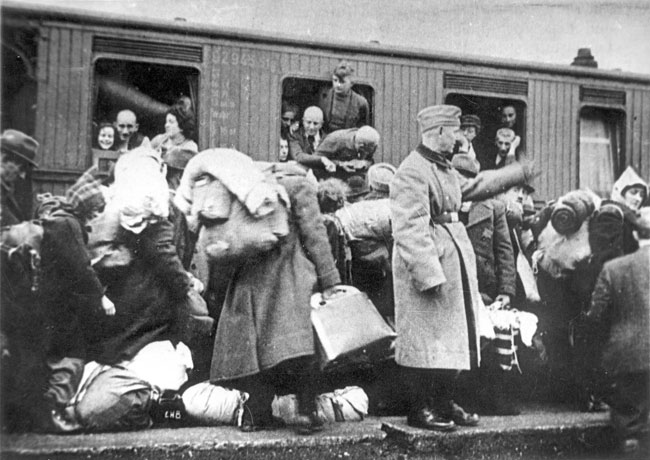 From 1941 onwards, deportation of Jews in Germany followed their exclusion. The German Jews in this picture are being deported to Riga. Source: Yad Vashem.
From 1941 onwards, deportation of Jews in Germany followed their exclusion. The German Jews in this picture are being deported to Riga. Source: Yad Vashem.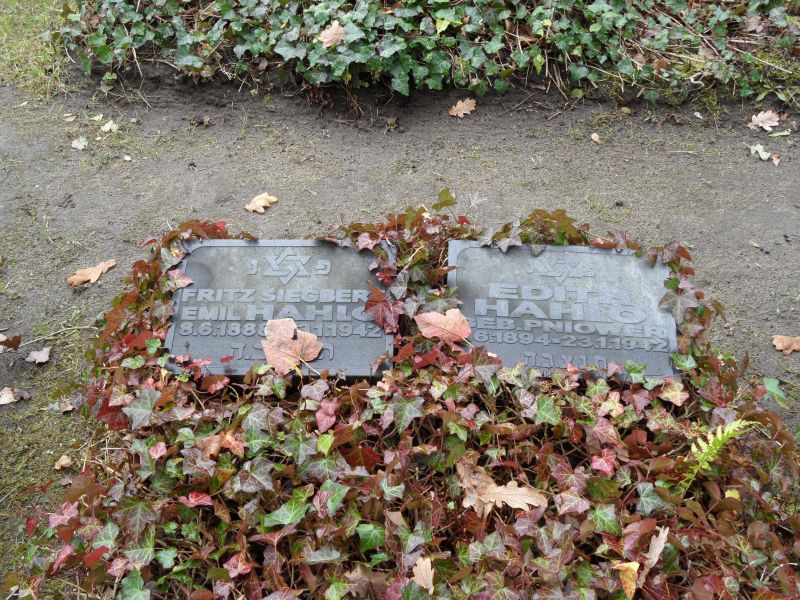 Tombstones of Fritz Siegbert Emil Hahlo and his wife Edith, who both committed suicide in Berlin on 23 January 1942. Source: Coen Prenger.
Tombstones of Fritz Siegbert Emil Hahlo and his wife Edith, who both committed suicide in Berlin on 23 January 1942. Source: Coen Prenger.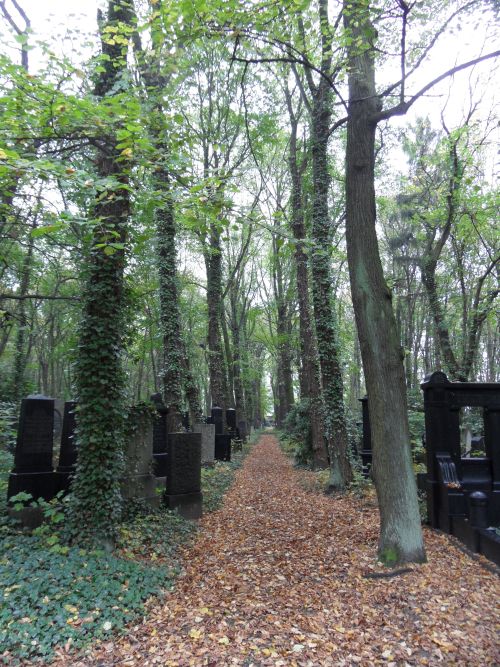 During the war, the cemetery was an oasis of peace and quiet for the children who were put to work here. Today the densely overgrown cemetery still emanates a pleasant serenity. Source: Coen Prenger.
During the war, the cemetery was an oasis of peace and quiet for the children who were put to work here. Today the densely overgrown cemetery still emanates a pleasant serenity. Source: Coen Prenger.After the war
On 23 April 1945, the first Russian soldier arrived at the cemetery while the battle for Berlin was still raging. "It was three o’clock in the afternoon," as rabbi Riesenburger remembered that day, "and the first Sovjet soldier came walking in through the gate of the cemetery. He walked ramrod straight. I had the feeling that he crumpled a piece of the the hated swastika flag with every step." After the German troops had surrendered in Berlin on 7 May 1945 and the war in Europe had come to an end, 28 year old Soviet soldier Michael Bodjana was buried by Riesenberger next to the field of honor of the First World War. The soldier had succumbed to his injuries in the Jewish hospital a few days before. Both the Soviet star and the Star of David are displayed on his tombstone.
As early as September 1945, a tablet in memory of the victims of the Holocaust was consecrated near the entrance of the cemetery by the Jewish community of Berlin, which represented some 8.000 survivors. On 27 January 1992, 47 years after the liberation of Auschwitz, an urn containing ashes from the crematoriums of the camp, was placed in the cemetery.
On 11 September 1949 an important ceremony took place when the Jewish resistance fighter Herbert Baum was reburied. He had been the leader of a Jewish resistance group which carried out a raid on an anti-Semitic and anti-Communist propaganda exposition in Lustgarten in Berlin on 18 May 1942. He and various others were arrested by the Gestapo a few days later and sentenced to death. 30 year old Baum died in Moabit prison on 11 June 1942 where he had been savagely tortured and was buried at Weissensee. He and 26 other convicted members of the resistance group and his wife Marianne are commemorated on a memorial stone in the cemetery. In 1951, the Lothringstrasse, the road leading to the cemetery, was renamed Herbert Baumstrasse.
The Communist eraIn Berlin, divided into occupation zones by the Allied victors, Weissensee was part of the Russian zone and from 1949 part of East Berlin in the German Democratic Republic or D.D.R. Many Jews left East Berlin before the Wall made it impossible in 1961. In 1949, one out of three Berlin Jews still lived in East Berlin, in the middle of the 50s, this had decreased to one in five. After the new Jewish cemetery Heerstrasse in the suburb of Charlottenburg had been opened in West Berlin, the number of funerals at Weissensee dwindled to no more than 10 per month. With the erection of the Wall, this number would decrease even further. The Communist era was bad for the cemetery at Weissensee. Due to a diminished Jewish community and a failing governemnt, the cemetery fell victim to vandalism and neglect. Graves became overgrown, tombstones fell over and the mausoleums, constructed of limestone, were eroded by acid rain.
From the 80s onwards, when the cold war had long passed its climax, more attention was paid to the cemetery which had turned into a jungle after all those years of neglect. International media heard of the sorry state of the cemetery from emigrated Jews who had visited the graves of their loved ones. In order to avoid more bad publicity, cleansing actions were launched by Christian organisations and the F.D.J., the Communist youth movement. Thanks to personal intervention by D.D.R. leader Erich Honecker in the 80s, construction of a six lane highway that would have cut the cemetery in two was prevented. In 1990, one year after the fall of the Wall, the West German Bundeskanzler and former mayor of West Berlin, Richard von Weiszäcker, paid a visit to the cemetery. He considered maintaining the Jewish graves a German duty.
World heritage"I am in charge of a museum, not a cemetery," Ron Kohlds said, the present director of the cemetery. The place portrays Jewish history from the 19th century onwards. The lavish mausoleums show the prosperity of the Berlin Jews during the reign of Kaiser Wilhelm while the graves of the victims of Nazi persecution testify to the downfall of the Jewish community in Berlin. However, the Jews have never disappeared from the German capital entirely. Today, there is a booming Jewish community again, consisting mainly of emigrants from former Soviet republics. With this, the cemetery also shows the resurrection of the Jews in Berlin. Today, 14 fulltime employeees are at work on the cemetery, where some 40 funerals are carried out every year.
Volunteers, pupils, students and hired professionals do their best to restore the cemetery to its original state as much as possible except those parts which have been designated protected areas due to the presence of rare plants and birds. More than 50 tombs have been restored in the past years, priority being given to the most vulnerable and most important. The German army also assists in maintaining the cemetery. Regular soldiers and reservists take particular care of the graves on the field of honor. Moreover, the Bundeswehr holds a memorial service every year near the Jewish war monument in memory of the Jewish soldiers who died in World War One.
The Jewish cemetery in Weissensee, the largest in Europe still in use, has been recommended to UNESCO as world heritage. "The unique importance of Weissensee does not only consist of the conspicuous artistic treasures but also of the unbreakable link to the history of the Jews of Berlin," so Hermann Simon, the present director of the New Synagogue and the Center for Jewish history and culture in Berlin, said to the press agency A.F.P. in 2011. "When I walk across the cemetery, I am reminded being part of a vast history which could have been ended but survived."
Definitielijst
- Holocaust
- Term for the destruction of European Jewry by the Nazis. Holokauston is the Greek term for a completely burnt sacrifice.
- Jews
- Middle Eastern people with own religion that lived in Palestine. They distinguished themselves by their strong monotheism and the strict observance of the Law and tradition. During World War 2 the Jewish people were ruthlessly persecuted and annihilated by the German Nazis. . An estimated 6,000,000 Jews were exterminated.
- Nazi
- Abbreviation of a national socialist.
- propaganda
- Often misleading information used to gain support among supporters or to gain support. Often used to accomplish ideas and political goals.
- raid
- Fast military raid in enemy territory
- resistance
- Resistance against the enemy. Often also with armed resources.
- swastika
- Equilateral cross, symbol of Nazi-Germany.
- Synagogue
- Jewish house of prayer.
Images
Information
- Article by:
- Kevin Prenger
- Translated by:
- Arnold Palthe
- Published on:
- 09-03-2016
- Last edit on:
- 02-05-2020
- Feedback?
- Send it!
Related sights
Related books
Sources
- MOORHOUSE, R., Berlin at War, The Bodley Head London, Londen, 2010.
- WAUER, B. & LOSIER, A., Der Jüdische Friedhof Weissensee, be-bra verlag GmbH, Berlijn, 2010.
- Förderverein Jüdischer Friedhof Berlin Weissensee
- Historic Jewish cemeteries in Berlin
- Jüdische Gemeinde zu Berlin
- Wauer, B., documentaire Im Himmel, unter der Erde, Salzberger & Co. Medien GmbH, Berlijn, 2011.
